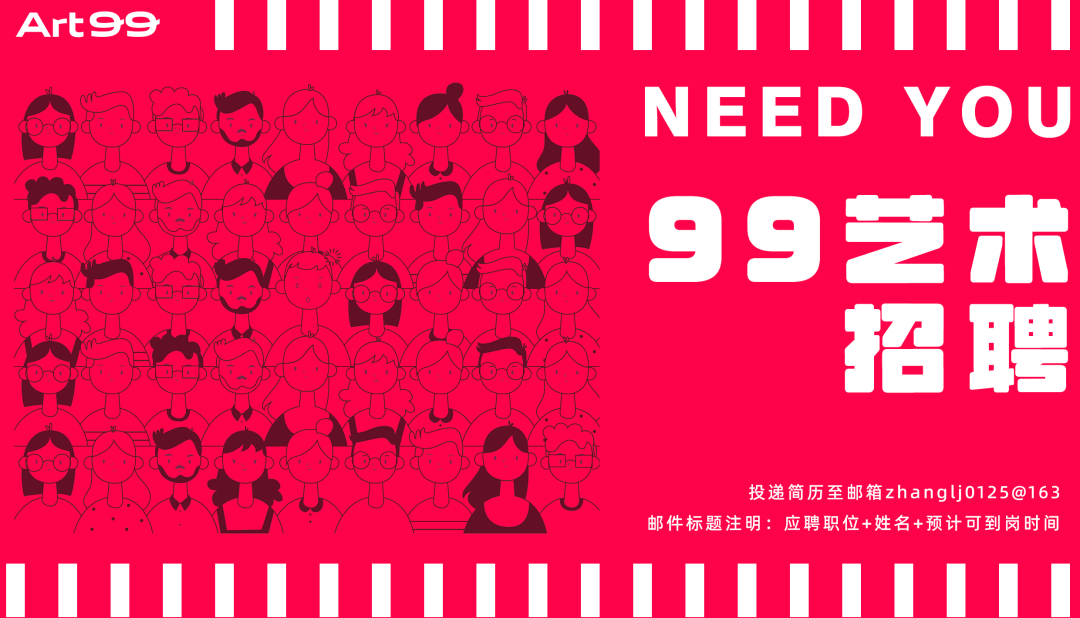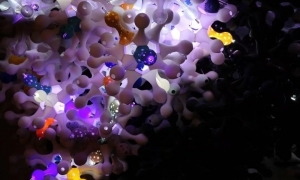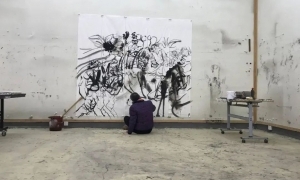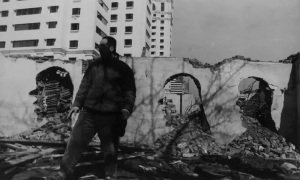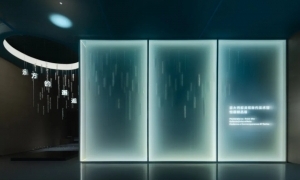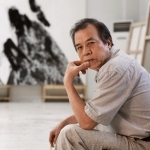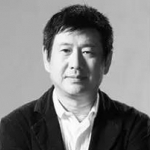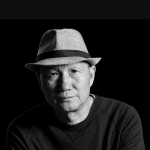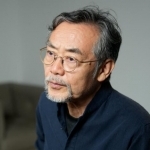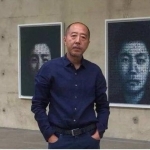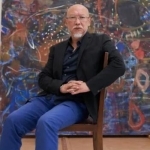自制 vs.机制 真实 vs.虚拟
周 彦 博士/教授/批评家
有朋友把彭博的六幅油画的数码照片寄给我,希望我写一篇推介辞。在了解了这位年轻艺术家的背景和他的思路以后,我欣然命笔为这位本来素不相识的80年代出生的年轻人写这篇短文,不光是他的画中流露出来的天真童趣使我想起了我自己的童年,而且他的思路也启发我重新思考今天的网络文化和机器制造文明这样的大话题,使得我们两个相隔几个世代且万里之遥的艺术中人忽然有了一种精神的契合。
彭博把这六幅描绘童时玩具的作品命名为“自制系列”,清楚地表达了他对“自制”的怀念。拨浪鼓﹑弹弓﹑铁环﹑陀螺﹑小桔灯﹑大风车,这些从五十年代出生的我们这一代到八十年代在农村出生的彭博这一代都再熟悉不过的玩具,被画家以极其简明的笔法描绘了出来。它在所有的画中都使用了上灰下亮的比例约为7:3的平涂背景,在我看来这似乎是一种“以空间暗示时间”的处理:当下是充满我们生活的鲜活但稍纵即逝的从而在一定意义上“单调”的经验,而历史随着时间的推移逐渐成为占据我们经验一部分的多色记忆。艺术家谈到他画这些画的初衷时说,“我原初萌意于儿时多彩娱乐生活的追忆,对当今单调娱乐方式的乏味。”和大部分沉醉于机制玩具和网络游戏的“少年郎”不同,彭博从变化多端的当代娱乐中看出了它的“异化”本质,即以一种套餐方式填鸭式的把人的天真和创造性挤压到一个几乎无处生存的境地,人本身成了只是操作按钮﹑滑鼠和键盘的机器和网络产品的奴隶。手工制作的乐趣和在制作过程中的成就感与自我实现似乎只有在记忆中才能找到立足的空间。
我注意到画家在处理每件玩具的表面时赋予了它们以一种单一的特别的质感,显然这并非是一种“客观地再现”,因为至少这六种玩具不会只有一种质感。这是一种很难用语言描绘的或许具有视觉多义性的“质感”:它像一种珠子(更具体点,珍珠?)的集合,又抑或是浸泡在液体里的苡米,而我宁可把它看成一种大脑皮层组织的“变体”。这种和“记忆”相关的历史在这里被处理成有特殊“质感”的表面,它的每一个隆起,每一个皱褶,似乎都饱含着画家记忆中亲手制作每一件玩具时的主意﹑动作﹑手与脑的互动,和其他小朋友的合作和竞争,自然也有失败的挫折和成功的快感。
自然,我们不能把这些画解读为通常意义上的“静物”,不仅因为静物需要多个物件的组合,也因为组合的静物需要有“空间关系”,更重要的是这些物品都是艺术家的“记忆图像”,生活中已几乎不存在的“物件”。所以彭博把它们单个处理,显示出每个“物件”在他的生活和历史中都具有不可混淆于它物的特点和独特地位。这些“物件”的非现实的“历史感”也通过去除光影﹑削弱透视关系来传达。于是我们在这里就会碰到一个有意思的问题:与现实中我们天天把玩的“虚拟现实”(virtual reality)比,哪一个更真实?历史的未必不是“现实”的,而现实的未必一定是“真实”的,这种看似悖论的陈述或许恰恰是一种贴近真实的描述。与此相关的一个问题是:自制和机制,哪一个更符合或切近人的本质?机器制造的“乐趣”看上去是开发了娱乐空间的无限可能性,使我们玩得更恣意,更自由,更多样化,更有互动性,可是却把最根本的东西给弄丢了,那就是彭博说的“自我价值的确认”和“多样的真实互动的可能性”,前者是关于个人价值的问题,后者是个人在群体中的沟通和价值实现的问题。
很高兴彭博画出了我们的儿时记忆,也很高兴他有如此与众不同的思考。回溯历史是为了警醒现在,批判当下是着眼于未来。认识机制的问题,回归自制的快乐,走出虚拟的空间,走进真实的现实,是彭博,也是我对自我和对当代人的一种期盼。
.
Self-made vs. Machine-made Reality vs. Virtuality
By Zhou Yan
Doctor/Professor/ Critic
One of my friends sent me six digital photographs of Peng Bo’s oil paintings, hoping that I could write an essay of recommendation for him. After having fully understood this young artist’s background as well as his thinking, I am so pleased to write this essay for the young stranger born in the 1980s, not only because the innocent children’s interest that reveals in his works reminds me of my own childhood, but also because his ideas have inspired me to rethink such big topics as today’s network culture as well as machine-made civilization, which causes a sudden spiritual agreement between the two of us, though being separated by one generation as well as tens of thousands of miles.
Peng Bo named the six works which describe the childhood toys “Self-made Series”, expressing clearly his memory of “self-made”. The toys such as rattle-drum, slingshot, iron hoop, peg-top, small orange light as well as big windmill, which are so familiar to the ones born in 1950s like me to those like Peng Bo born in the countryside in 1980s, have been described by the artist with the plainest technique. The background of upside grey and downside light with a proportion of approximate 7:3 is used in all his paintings, which seems to be a kind of “implying time by space” technique: the present is vivid as well as transient, which seems to be “monotonous” in a certain sense, while the past has gradually become a colorful memory that takes up part of our experience as time goes by. Talking of his original intention of creating these paintings, the artist said, “My original intention is to look back upon the colorful entertainment life of my childhood and show today’s tedious entertainment styles.” Different from most of the “youngsters” who indulge in machine-made toys and online games, Peng Bo has seen its “alienation” nature from the various modern entertainments, that is, to squeeze human’s puerility and creativity to the brink of ruin by spoon-feeding “meals”, making people become slaves of machines and network products ,who can only operate buttons, mice and keyboards. It seems that the joy in hand-making toys as well as the sense of accomplishment and self-realization in making process can only find its foothold in the memory.
I noticed that the artist endowed the surface of each toy with a single but unique quality sense. Obviously, this is not just an “objective reproduction”, because at least the six toys cannot have the same quality sense. It is a kind of “quality sense” that is very difficult to express in words and perhaps has visual ambiguity: it feels like a collection of beads (more specifically, pearl?) or Job’s tears dipped in the liquid, but I would rather regard it as a kind of “variant” of cerebral cortex tissue. The history which is relevant to “memory” has been reworked into the surface with special “quality sense”. Each of its hunch and gauffer seems to be full of memories of the ideas, actions, interactions of hands and brain, the cooperation and competition with his fellows as well as the frustration over failure and the rejoicing over success when the artist was producing the toy.
Of course, we cannot treat these paintings just as general “still life”, not only because still life should be a combination of a number of objects, but because there should be a “space relationship” between the still lives. More importantly, all these works are the artist’s “memory images” and the “objects” which can hardly be found in our daily life. Therefore, Peng Bo has dealt with them one by one to show the distinctive characteristics and unique position of each “object” in his life and history. The unrealistic “sense of history” of the “objects” has been expressed by wiping off light shadow and weakening perspective relation. Thus we will meet with an interesting question: compared with the “virtual reality” that we play with everyday in real life, which is more realistic? Things in history may not necessarily be “unrealistic”, while things in reality may not necessarily be “true”. This statement which sounds like a paradox perhaps is more close to the true description. A question related to this: the self-made and the machine-made, which is more in keeping with or close to human’s nature? It seems that the “joy” of machine-made toys has developed the boundless possibilities of entertainment space and made us enjoy ourselves more wantonly and freely with more diversification and interaction, but has lost the most essential things, which are Peng Bo’s “confirmation of self-value” and “the possibility of various real interaction”. The former is concerned with issues of individual value, while the latter is about the issues of communication of individuals with others and their value realization.
It’s lucky that Peng Bo has drawn our memories of childhood with his distinctive thinking. Tracing back the history is to warn us today, and criticizing present is to look to the future. Realizing the problems of machine-made gadgets, regaining the joy of self-made objects, walking out of the virtual space and into the true reality is the expectation of Peng Bo and me for self as well as all the people today.
【编辑:贾娴静】


